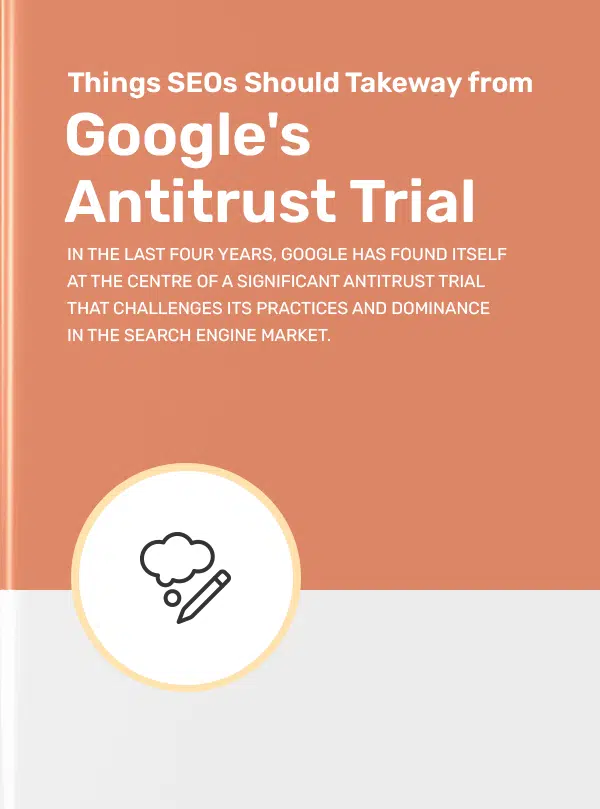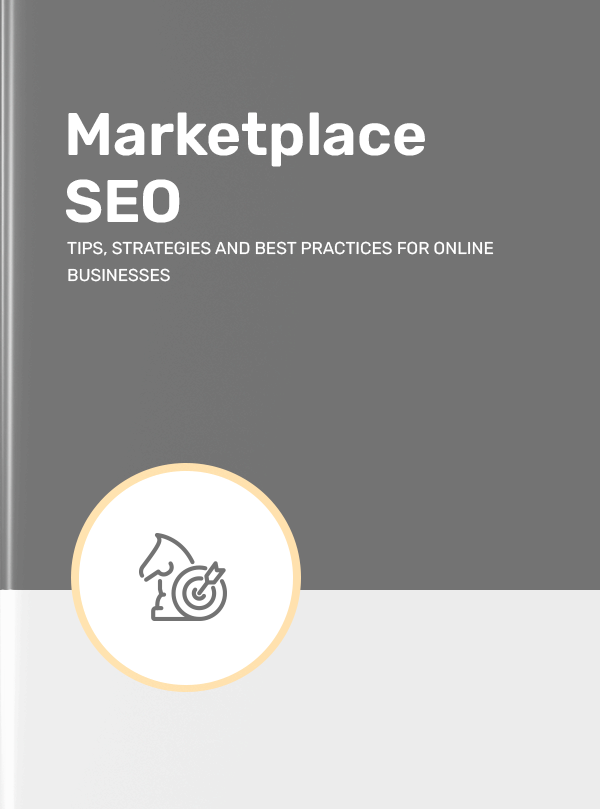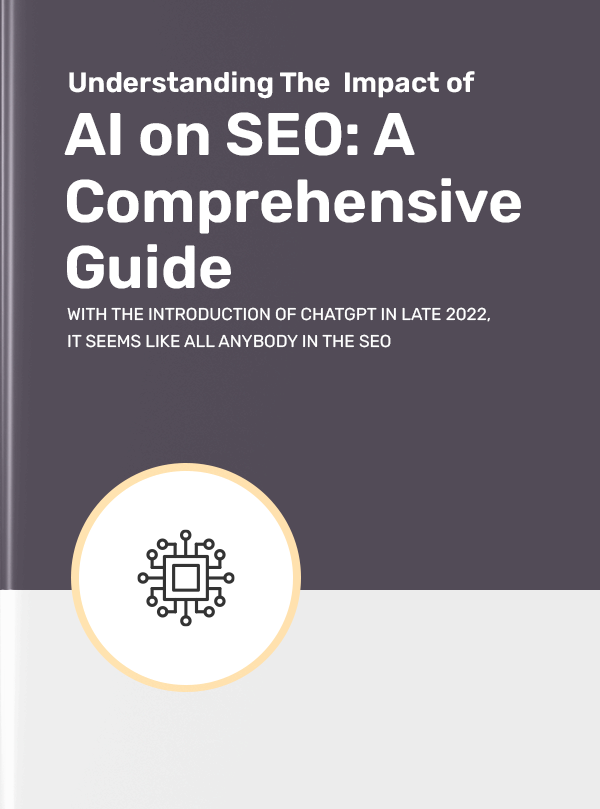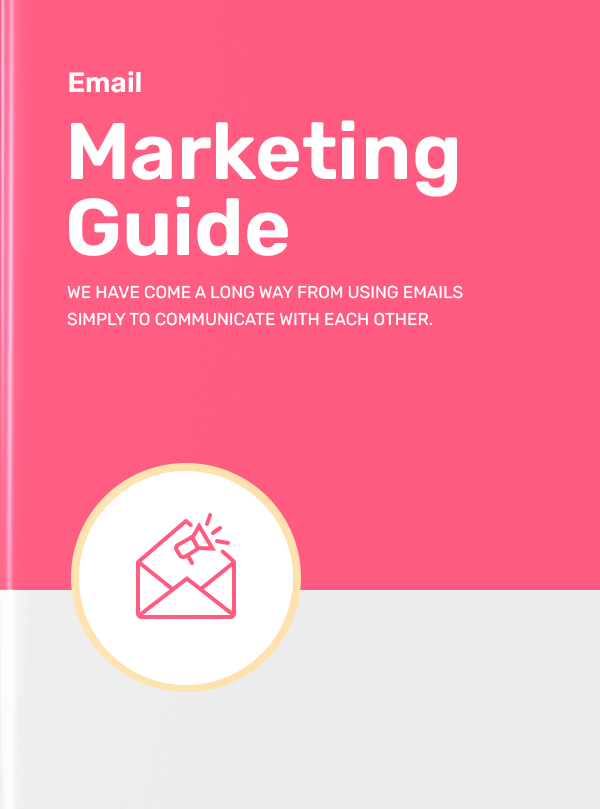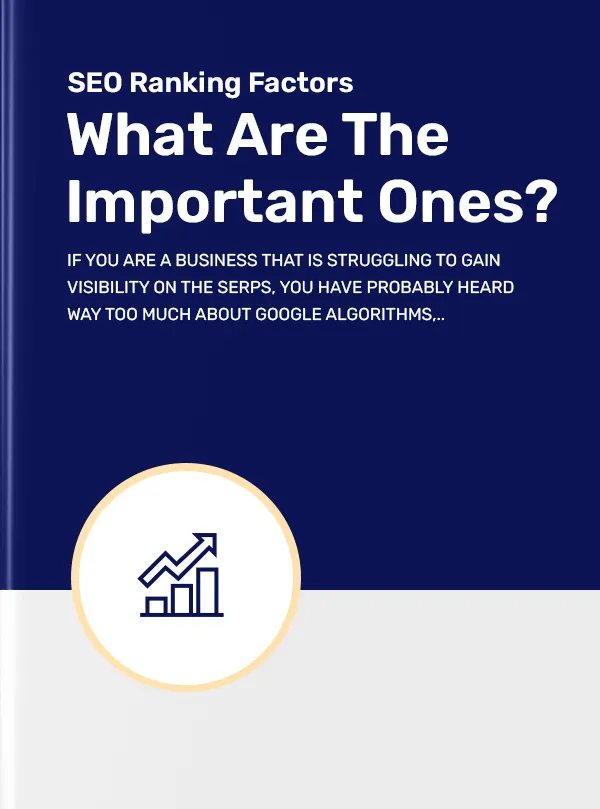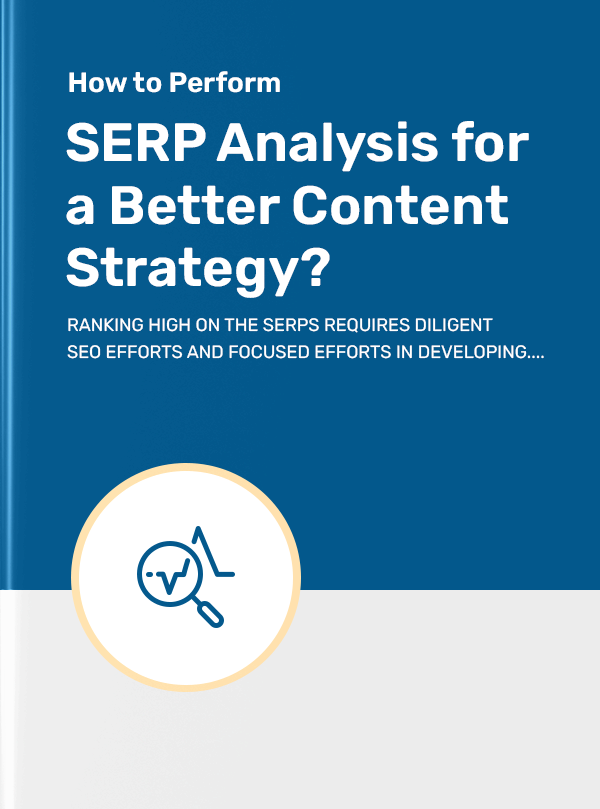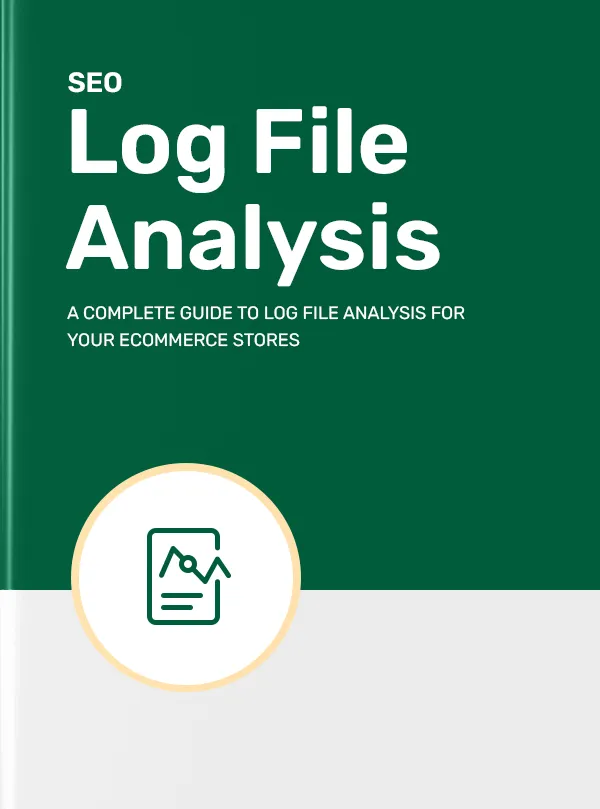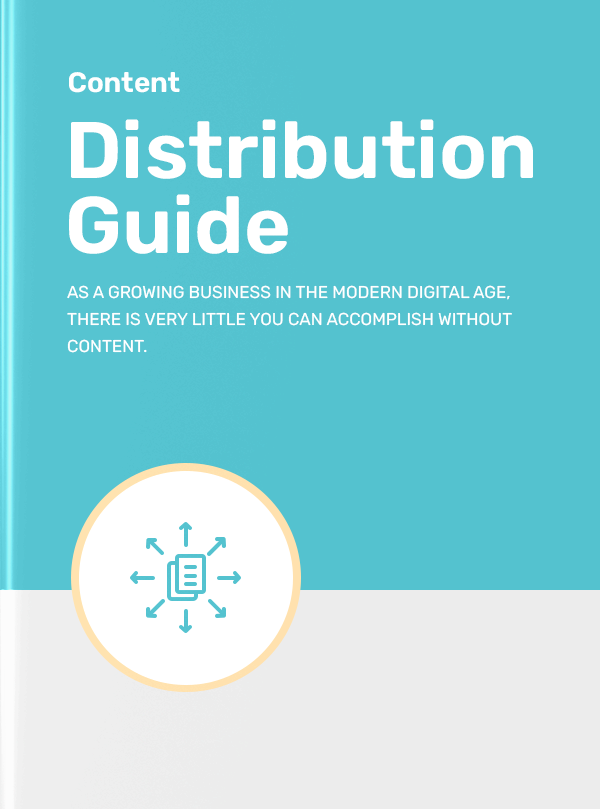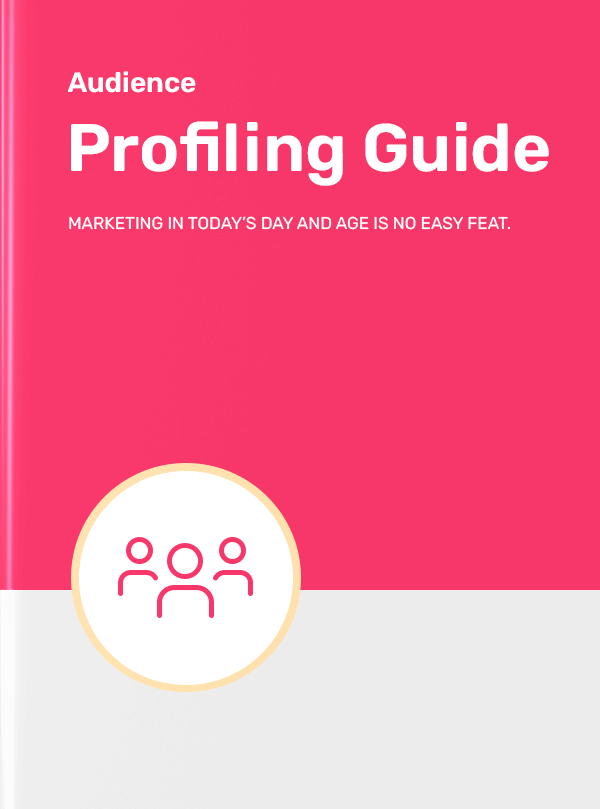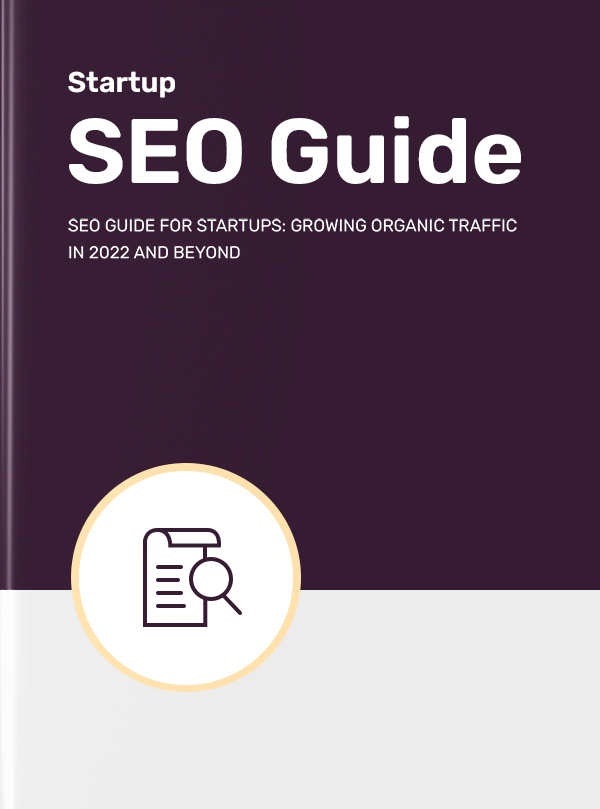Get a Free Seo Audit in Minutes
Get a Free Google SGE and How It Will Impact SEO in Australia SEO Audit in Minutes
Since the announcement of ChatGPT, AI has become mainstream in nearly all areas of marketing and tech — from planning to content generation. Most marketing tools now offer AI-powered features, and in one way or another, AI has become an integral part of our daily workflows.
- Google Search Generative Experience (SGE) has been renamed to AI Overviews.
Google announced at its I/O developer conference in May 2024 that it is integrating the Google Search Generative Experience, now renamed as AI Overviews, into its general search results pages in the US.
As you would imagine, search engines are no different.
In May 2023, Google launched the Search Generative Experience (SGE), an AI-enhanced search feature currently in beta accessible via Search Labs. This initiative marks a significant transformation in how search results are generated and displayed, and is bound to have extensive implications for SEO.
For the first time, Google’s SERP is generating new content based on retrieved data — not merely curating and organising existing content — to give users quick and clear answers to their search queries so they don’t need to visit individual links.
In this detailed article, you’ll learn everything you need to know about Google’s SGE and what it could mean for SEO in Australia as well as globally.
What Is AI Overviews / Google SGE?
Google’s Search Generative Experience (SGE) is an advanced search functionality that incorporates powerful AI algorithms to improve the efficiency and relevance of search results.
By leveraging large language models (LLMs) like the Multitask Unified Model (MUM) and Pathways Language Model 2 (PaLM2), SGE provides enriched, contextual responses directly on the search results page. This tool aims to make information discovery on the web faster, more intuitive, and significantly more comprehensive than traditional search methods.
Currently in the experimental phase, SGE can help in various ways, such as:
- Getting quick answers and how-to instructions
- Learning about a topic overview quickly
- Summarising key takeaways
Say, you’re searching for how to make purple colour. Pre-SGE, Google directed you to sites that share how-to articles, along with displaying video results from sites like YouTube. With SGE, the very top spot of the SERP shows an AI-generated answer that’s compiled from multiple sources, followed by the usual search result links.
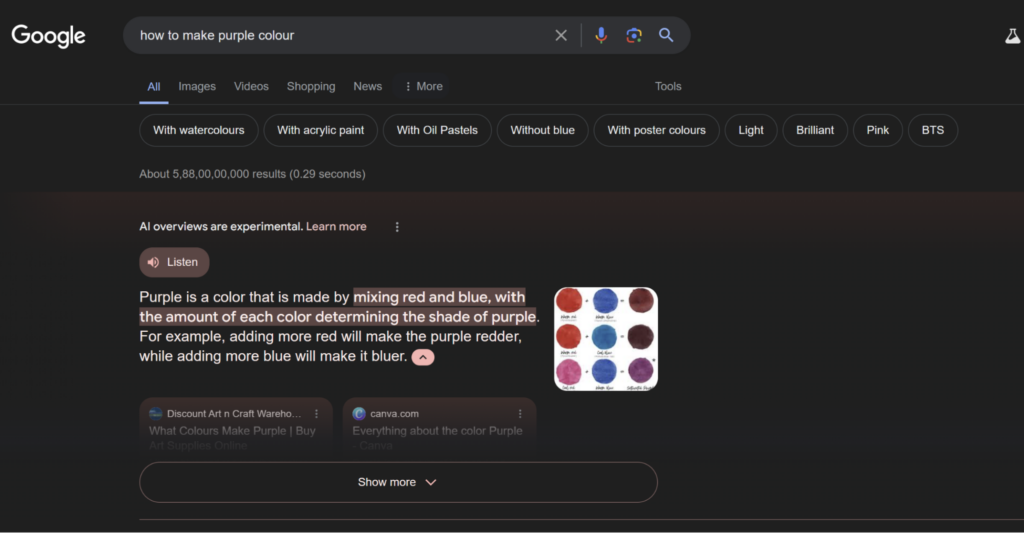
You can click “Show more” to get a detailed answer that cites its sources alongside, which you can click to learn more. You can also ask follow-up questions and mark the answer with a thumbs up or a thumbs down.

The Mechanics Behind AI Overviews / Google SGE
SGE utilises a blend of Google’s proprietary technologies, including BERT (Bidirectional Encoder Representations from Transformers) and newer models such as MUM (Multitask Unified Model) and PaLM (Pathways Language Model). These models enable the system to understand and generate human-like responses to complex queries.
Here’s a basic overview of the step-by-step process:
- Query Understanding: SGE first interprets the user’s query using natural language processing (NLP) to grasp subtleties and intent.
- Information Retrieval: It then fetches relevant information from a vast index of web pages, ensuring a wide range of data is considered.
- Content Generation: Using generative AI, SGE synthesises information into a coherent, contextually relevant answer that’s displayed at the top of search results, accompanied by cited sources.
- Response Refinement: The system also allows follow-up questions that turn into a conversation, offering users a comprehensive exploration of the subject matter.
Turning On The Power of AI Overviews / Google SGE
SGE is currently in experimental mode, so you need to opt in to use it. It is available in 120+ countries (not yet available in Australia) and seven languages.
Here are the general steps to enable Google SGE:
- Open Google Chrome or the Google app on your device.
- Navigate to ‘Settings’ and select ‘Labs’ or ‘Experiments’ (this option might be named differently depending on your region).
- Find the card labelled ‘Search Generative Experience’ and toggle it on.
- Agree to any terms of service if prompted, and you’re all set to try the enhanced search feature.
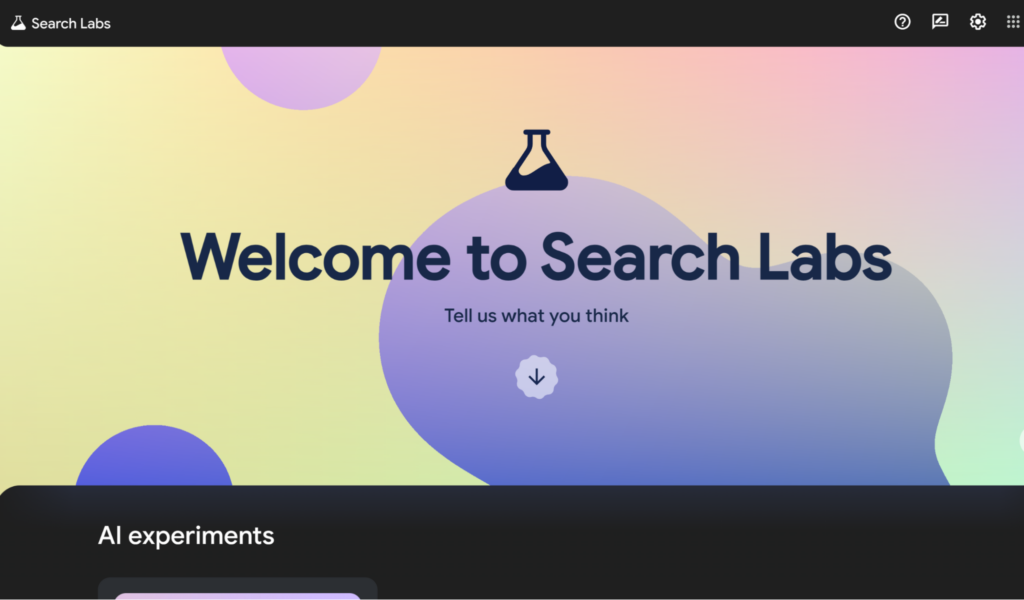
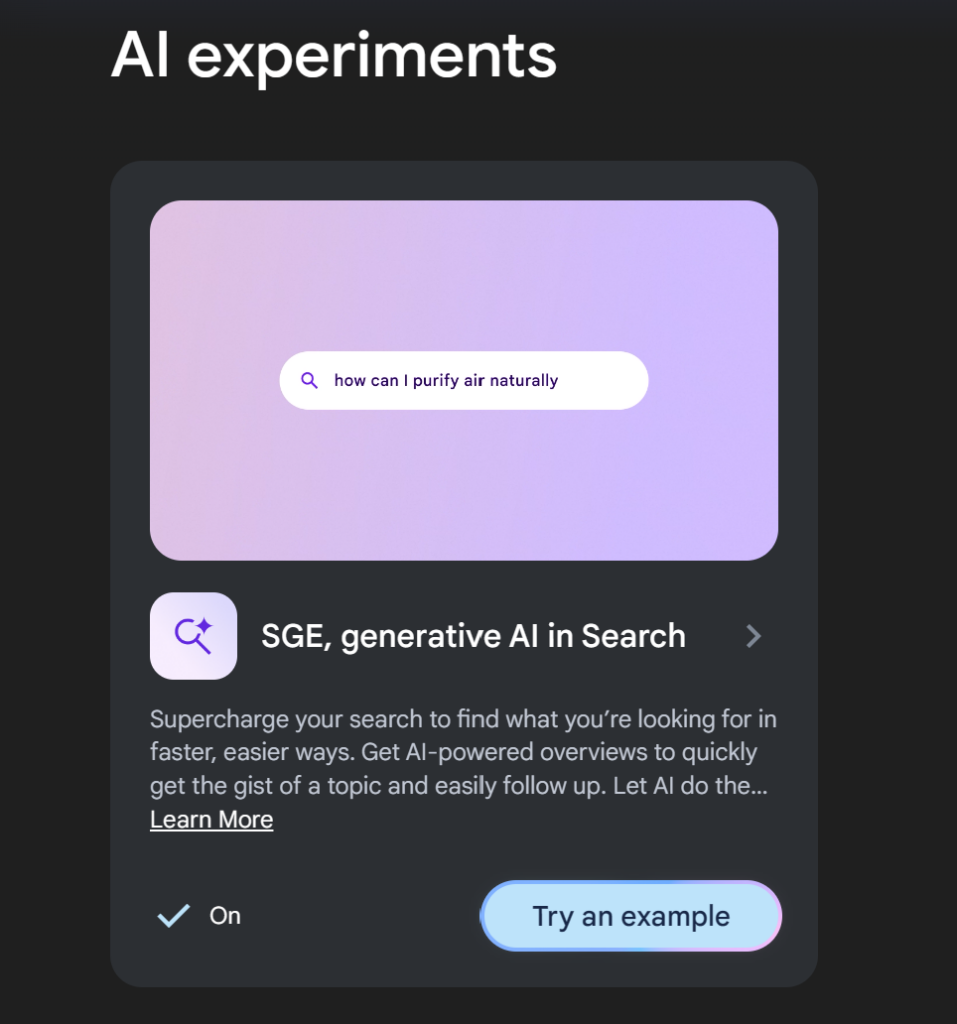
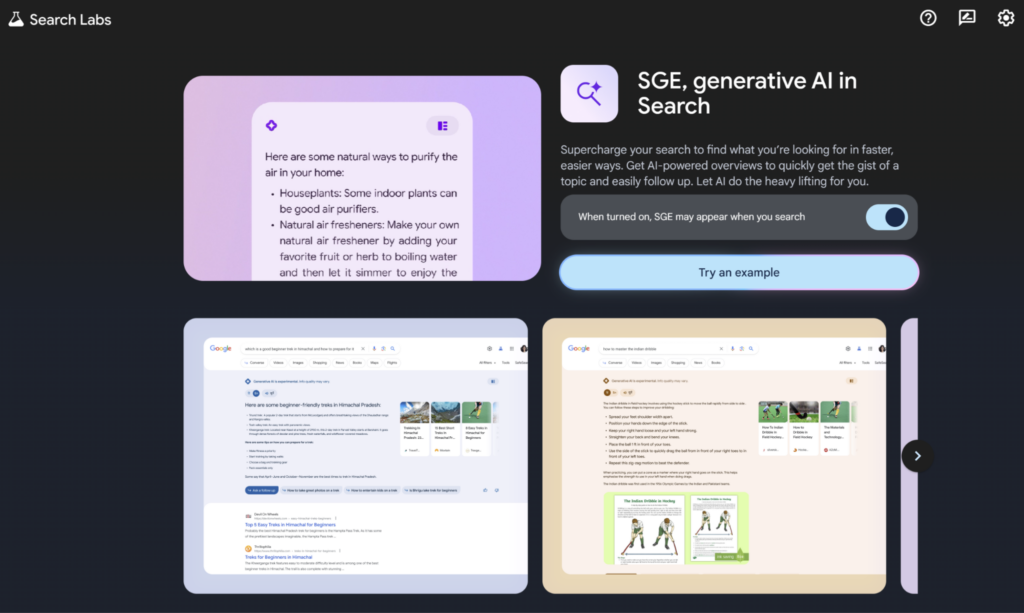
As of the latest updates, Google SGE is set to expand progressively around the world. While an official launch date for Australia has not been specified, the rollout in other regions suggests it could be available soon as part of a phased global deployment. Keep an eye on Google’s official announcements for the most accurate and timely information regarding local availability.
The Core Advantages of Google’s Generative AI in Search
By now, you must have tried a generative AI tool like ChatGPT or Midjourney. SGE essentially harnesses that same impressive power of generative AI to transform how users interact with search engines.
Here are the core advantages of integrating generative AI into search processes.
A Glimpse into Complex Topics
Generative AI excels in breaking down complex topics into digestible summaries. SGE uses deep learning algorithms to analyse extensive data sets, enabling it to understand nuanced topics and provide comprehensive overviews. This capability is particularly beneficial for educational purposes, research, and whenever a quick understanding of a complex subject is needed.
- Contextual Understanding: By employing models like MUM, SGE can relate different concepts across various languages and formats, offering users a more holistic view without the need for multiple searches.
- Integrated Knowledge: It synthesises information from multiple sources, providing a single, consolidated response that highlights the most relevant facts, figures, and viewpoints.
More Engaging Results
SGE is designed to make search results more engaging by utilising AI to generate responses that are not only informative but also interactive.
- Dynamic Interaction: Users can ask follow-up questions directly in the search results, prompting the AI to dive deeper into the subject matter without additional searches.
- Personalised Experience: Over time, SGE learns from individual search habits and preferences, tailoring responses to be more aligned with the user’s specific interests and past interactions.
Achieving Faster and Direct Access to Information
One of the most significant advantages of SGE is the speed and directness with which it delivers information.
- Speed: Generative AI can quickly process and summarise vast amounts of information, significantly reducing the time users spend searching for credible results.
- Direct Answers: Instead of presenting users with a list of links, SGE offers a direct answer to queries at the top of the search results page, often eliminating the need to click through to external sites.
- Efficiency: By minimising the need for multiple searches and direct interactions with possibly irrelevant content, SGE not only speeds up the search process but also makes it more efficient.
AI Overviews / Google SGE and the Evolution of AI-Driven Search
Google’s SGE, with its advanced AI capabilities, is set to redefine the search experience by providing quicker, more accurate, and contextually relevant information. This initiative not only enhances user engagement but also improves overall access to knowledge, empowering users to make day-to-day decisions more efficiently.
As SGE continues to evolve, Google’s ambition is to further integrate AI innovations that will expand the SERP’s capabilities and retain Google’s dominance as the biggest search engine.
With generative AI, Google is transforming brand interaction and user trust:
- Enhanced Branded Content Discovery: Through AI-generated snippets and summaries, authoritative brands can gain higher visibility as their content is more likely to be featured prominently in search results.
- Semantic Search Enhancements: By understanding the semantics behind content, SGE can better match user queries with brand content, enhancing the likelihood of discovery and interaction.
- Cross-Referencing Capabilities: Employs techniques to cross-verify facts and figures, pulling data from multiple sources to enhance reliability and accuracy.
- Intent Recognition: By analysing the context in which queries are made, SGE can discern the user’s intent more accurately, leading to more relevant and trusted responses.
- Sentiment Analysis: Integrates sentiment analysis to better understand the emotional tone of queries, which helps in fine-tuning the responses provided.
- Conversational AI: Facilitates a two-way conversation between the user and the search engine, mimicking a human-like interaction that can lead to higher engagement rates.
- Dynamic Content Presentation: Unlike static search results, SGE can generate dynamic content such as instant answers, comparative overviews, and interactive elements, which engage users more deeply.
Now, you must be wondering: how does SGE compare with similar generative AI tools? Let’s find out.
Google AI Overviews vs ChatGPT
Since arriving on the scene in November 2022, ChatGPT hit 100 million users in two months.
Though Google SGE and ChatGPT both utilise advanced AI and large language models, they are built for different purposes and operate on distinct mechanisms.
ChatGPT is meant to serve more as a virtual assistant to help with brainstorming and other daily (and more complex) tasks. It may not use real-time information from the web and answer based on its training data. Whereas Google SGE is better for, you guessed it, quickly searching specific information from content published on the web.

Google AI Overviews vs Bing
In the search engine market, Microsoft’s Bing was the first search engine to integrate generative AI results to answer user queries.
As you can see in the screenshot below, Bing AI and SGE are quite similar. Both encourage follow-up questions and provide a quick snippet of information.
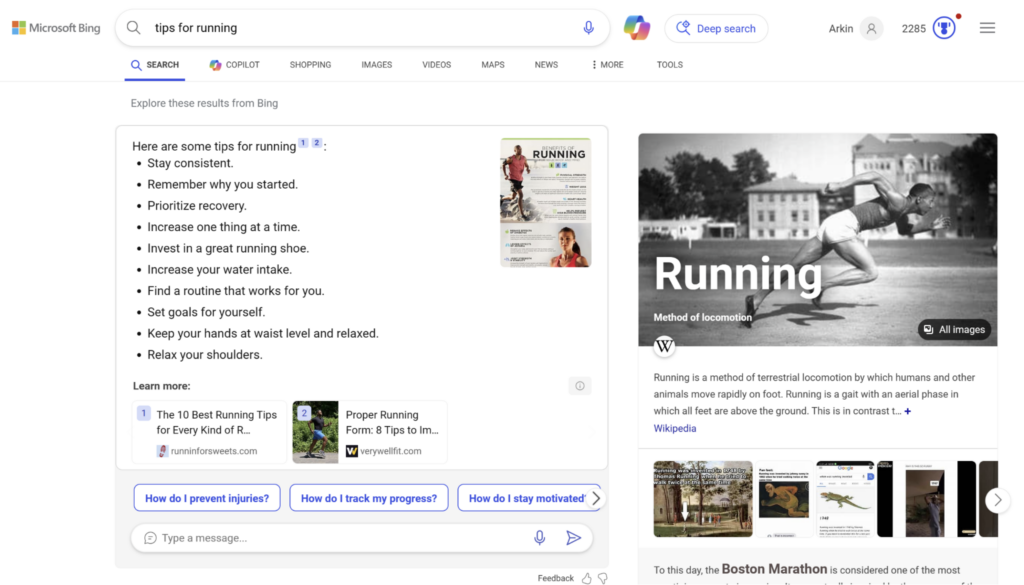
You can also switch to the Copilot mode to go into a complete conversation with the AI, similar to ChatGPT.
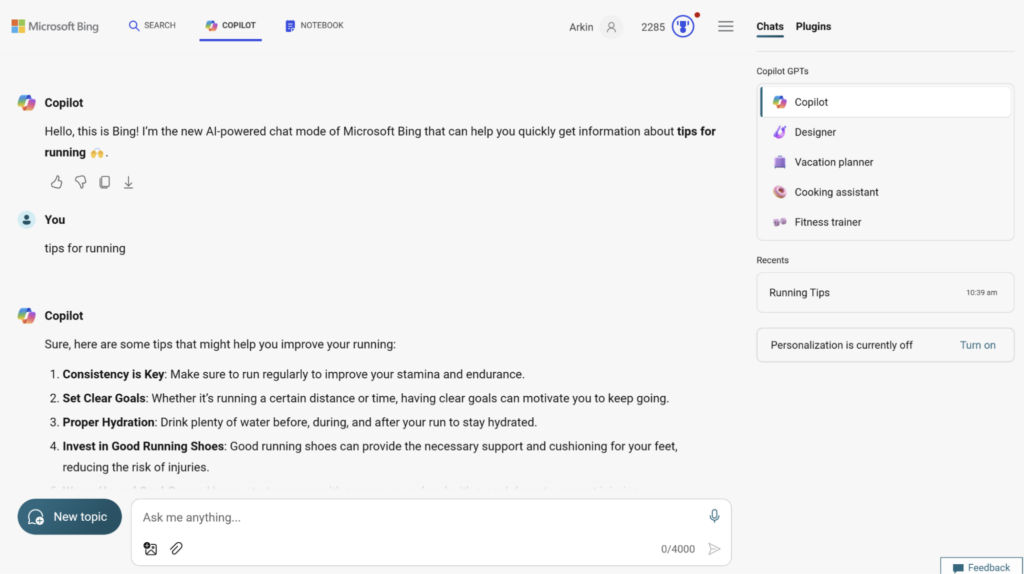
Overall, both serve the same purpose and seem equally capable of returning good results, but Bing is available to all users worldwide, so it has an edge (no pun intended!) in that regard.
Google AI Overviews vs Perplexity AI
Perplexity uses AI to answer queries with the aim of directly competing with traditional search engines by providing precise and reliable answers supported by citations. It is a great tool for deep research on a topic.
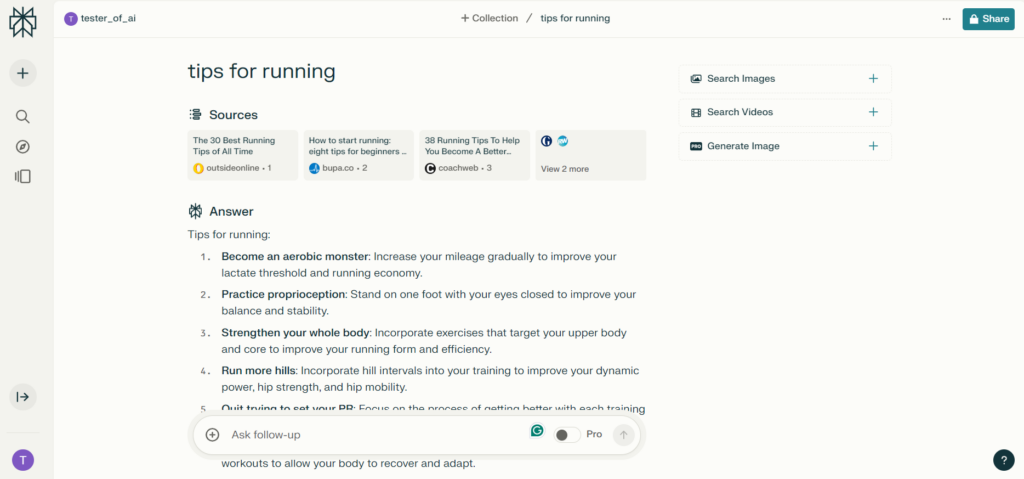
The platform strives to boost user trust through transparent methodologies, showing sources and calculations behind the AI’s responses. Its chat-like interface is cleaner and more suited to gaining an in-depth understanding of complex subjects, as opposed to SGE’s primary purpose of providing quick overviews and actionable advice.
Navigating the Challenges and Ethical Considerations
The introduction of AI into search, such as Google’s Search Generative Experience (SGE), brings several potential downsides that necessitate careful consideration. Let’s look into them.
Geographic Limitations and Accessibility
A current challenge of SGE and similar AI technologies is their uneven geographical distribution and accessibility. While AI-driven search tools are advancing rapidly in certain parts of the world, other regions with limited internet infrastructure or regulatory restrictions may not experience these innovations equally. This disparity can lead to a digital divide, where only a portion of the global population benefits from AI’s capabilities in search.
Balancing Accuracy with AI Creativity
AI models, including those used in SGE, aim to balance between delivering factually accurate information and generating creative, engaging content. The challenge lies in ensuring that the AI’s creativity does not compromise the factual integrity of the information presented.
This is especially critical for YMYL subjects that are based around a person’s well-being, such as finance and health. Google cannot afford to show inaccurate information due to user safety concerns.
Several users report issues like “hallucination” where the AI might generate incorrect information, and “bias” where the AI’s training data might influence the neutrality of the answers.
Techniques such as cross-referencing within large data sets and ongoing training with verified information are crucial to maintaining this balance.
Ensuring Visibility Amid AI Integration
As AI begins to curate and summarise content directly in the search results, concerns about the visibility of original content sources grow. Brands and content creators face the challenge of adapting their SEO strategies to ensure their content remains visible and relevant in an AI-dominated search landscape. This involves understanding and aligning with the AI’s content selection criteria, which may include directness, relevancy, authority, and user engagement metrics.
In fact, SGE can also mean lesser visibility for paid search. This is a crucial concern as pay-per-click (PPC) advertising on Google is an important traffic and revenue source for many brands. SGE shouldn’t drive away those brands.
Transparency and User Trust Issues
Transparency is fundamental to building and maintaining user trust, especially as AI systems increasingly influence what information is shown.
Users have also reported mixed experiences regarding the speed of response and the relevance of the information provided, in comparison to Google’s traditional search results.
Google’s PaLM 2 is a closed model, so it doesn’t disclose its decision-making process. This lack of transparency doesn’t bode well with people’s desire to know how AI spits results.
So, to maintain trust, SGE must continually help users understand how AI-generated answers are derived, including the data sources used and the processes involved. Providing clear explanations and maintaining open channels for feedback is vital for addressing users’ concerns about bias, privacy, and data security.
Overall, here’s a quick rundown of the current challenges with Google’s SGE:
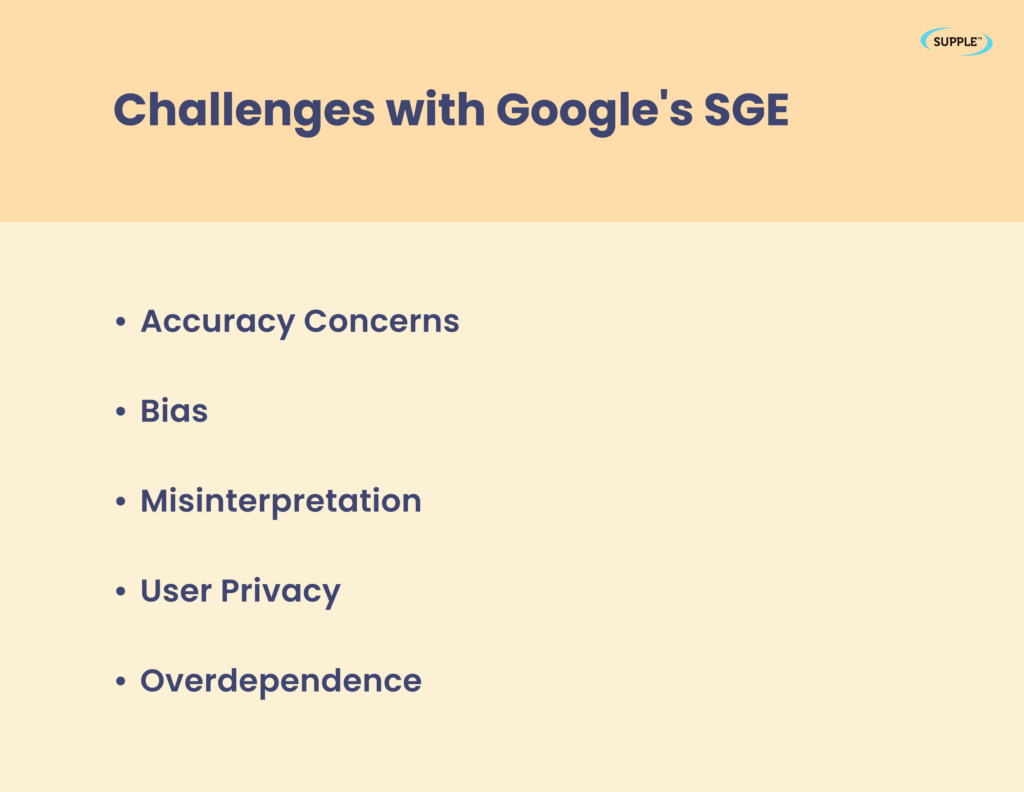
- Accuracy Concerns: Issues like “hallucination,” where the AI might present incorrect facts or skewed insights, pose a significant challenge to reliability.
- Bias: Despite using high-quality data, the training material for AI, inherently created by humans, can introduce biases that may skew AI responses.
- Misinterpretation: The AI’s interpretation of nuanced language could lead to discrepancies between user intent and the information provided.
- User Privacy: Integrating AI into search raises concerns about how user data is utilised and protected.
- Overdependence: The high efficiency of AI in delivering quick answers could lead to a reduced drive for users to seek deeper, more diverse insights.
Each of these areas requires attention and ongoing refinement to ensure SGE can deliver its intended benefits without compromising ethical standards or user trust.
Now, as touched upon, one of the challenges is for brands and creators to adapt their SEO strategies to ensure that their content remains visible and relevant in an AI-first search era.
Let’s talk about this in the next section.
The Future of SEO in the Age of Google’s Generative AI
As SGE becomes more mainstream across the world, the landscape of SEO is poised for considerable changes. For search marketers and brands, understanding and adapting to these shifts will soon become a must.
Preparing for a Shifting Landscape: SEO & AI Overviews Results
As we’ve seen so far, gen AI in search has its ups and downs in terms of SEO. It’s pretty clear that overall, organic traffic numbers for everyone are going to go down. According to a recent study, here’s how things are panning out:
- Impact on Visibility: SGE drastically reduces the prominence of the top organic search results, pushing it down by an average of 1,200 pixels.
- Variety of Sources: 62% of the links generated by SGE come from domains not included in the top 10 organic search results, thus introducing new competition from diverse sources that could challenge established SEO tactics.
- Strategic Content Development: The research recommends a shift towards producing comprehensive, multimedia-enriched content and establishing a strong presence across multiple platforms to improve visibility in SGE.
- Brand and Local Search Dilemmas: SGE could include links to competitors in searches specific to brands, potentially undermining brand authority and adversely impacting local search performance.
Overall, SGE impacts SEO by placing a higher premium on directly answering user queries within search results. This shift reduces the need for users to click through to external websites, emphasising a different approach to content optimization for visibility, utility, and directness in answering questions.
However, on the flip side, lower organic traffic could also mean more qualified traffic that’s more likely to convert.
That’s because while SGE does a good job of answering basic queries directly on the SERP (such as for “what is” keywords) — potentially reducing click-through rates for those queries — for in-depth reading and research, users would still need to click on the cited sources. When this happens, the odds of them having a greater intent to engage or convert are higher.
Besides, Google is combining AI-generated content with traditional search results — not completely replacing them. The usual blue-linked results would still be present below the AI-generated response. Not to mention only users who’ve opted to use SGE will see the different SERP. Not everyone is a fan of AI in search (at least for now).
So, all in all, we can expect SGE to have a mixed impact on SEO traffic.
That said, it’s not a bad time for SEO and content marketers to begin adapting their approach to SGE. Here are three key areas to focus on.
Leveraging Long-Tail Keywords for Enhanced Discoverability
Experiences with SGE so far suggest that it prefers that its users search with detailed queries instead of short phrases. So, this could mean shifting your focus to using more long-tail keywords in your content.
For example, instead of optimising only for “walking shoes”, consider including all long-tail variations as well to make the content more specific, such as “comfortable walking shoes for daily use”.
Crafting Quality Content that Resonates with AI and Users
Just like traditional search engines, SGE aims to provide users with relevant and helpful content, but it also focuses on making the search experience quicker and simpler.
Creating high-quality content that Google values involves using trustworthy sources, incorporating expert opinions, and ensuring the accuracy of the information you provide.
It’s crucial to understand and cater to search intent, which is essentially the reason behind a user’s search. There are four main types of search intent:
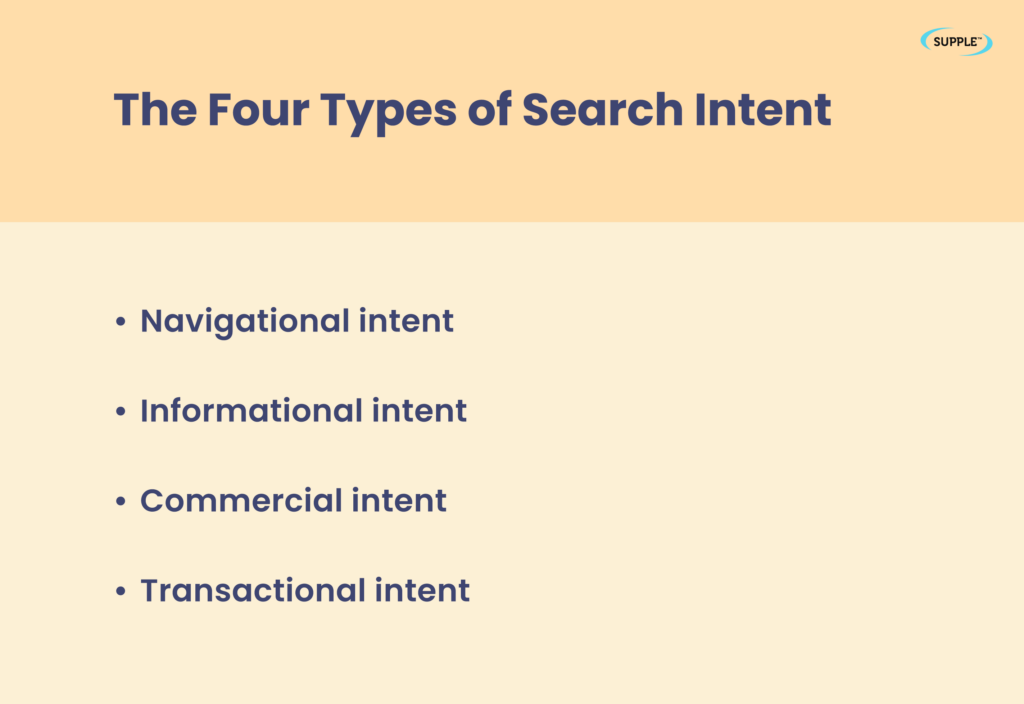
- Navigational intent: Users are looking for a specific page, like “Salesforce login.”
- Informational intent: Users want to learn something, such as “what is Salesforce CRM?”
- Commercial intent: Users are digging around before they buy, for example, “best CRM for agencies”
- Transactional intent: Users are looking to complete an action, usually a purchase, like “Salesforce free trial”
After selecting your keywords and identifying the intent, examine the search engine results page (SERP) to see:
- What makes the top results the best
- The depth of information in the top results
- Ways you can provide even better content
For instance, for informational keywords, you might include more data and examples than your competitors to stand out. Or, if users are looking to complete a task, offer clear, step-by-step instructions.
Understanding search intent is particularly vital for SGE because Google’s AI summary links only to content that best aligns with user intent, usually (but not necessarily) pulling from the top results.
Prioritising Natural Language for AI Comprehension
SGE gets everyday language, so it’s best to talk the way your audience does. This is especially important for voice search.
In addition to formal phrases like “we offer SEO services” on your homepage, go for something more approachable like “we help websites rank high on Google.
Google SGE: A Forward-Looking Vision
We’ve discussed extensively the potential positive and not-so-positive impacts of SGE for SEOs, and what we as marketers can do to prep for the AI-powered search landscape.
So, what lies ahead for this technology? Let’s delve into the significant milestones and future directions of Google SGE.
Google’s AI Milestones with DeepMind and Gemini
DeepMind is a division of Alphabet, Inc. responsible for developing general-purpose artificial intelligence (AGI) technology. It uses raw pixel data as input and learns from experience.
Google’s collaboration with DeepMind and the development of the Gemini model (originally released as Bard) mark critical milestones in AI. In particular, the introduction of Gemini, a new family of language models, brings more nuanced understanding and improved conversational abilities to Google SGE.
These advancements underpin SGE’s capabilities, enhancing its ability to understand complex queries and deliver more accurate, contextually aware search results.
Local Packs and Personalization: The Next Frontier
SGE has a local module that includes maps, for queries where regional relevance is essential.
Google’s focus on local packs aims to optimise local search results by providing more geo-specific information directly within the AI-generated snippet. This could overhaul how users interact with local business listings, events, and activities.
SGE utilises Google Business Profiles to source reviews for its local packs. These local packs are designed to be interactive, providing users with easy access to in-depth details with a simple click. Based on a few queries, it looks like these packs are specifically prominent in sectors like Restaurants and Travel, where localised information significantly enhances the search experience.
However, for B2B and Entertainment-related queries, local SGE modules are notably absent, indicating a strategic deployment tailored to the specific needs of different search categories.
Here are some tips to win local results in Google SGE:
- Manage Reviews Actively: Engage regularly with your reviews by monitoring and responding. This not only boosts your reputation but also increases your visibility in SGE’s local search results.
- Optimise Local Listings: Customise your local listings to cater specifically to location-based queries. This ensures your information is both relevant and easily accessible to users searching within your locality.
- Keep an Eye on SGE Deployments: Monitor how SGE utilises local modules across different searches. SGE can detect and display local intent even without explicit location-specific terms in the queries. Understanding these deployment patterns can help refine your SEO strategy to better align with how SGE operates, enhancing your content’s effectiveness in local search results.
Addressing Copyright and Organic Search Traffic Concerns
With more AI-generated content on the SERP, Google is facing challenges related to copyright and the preservation of organic search traffic. There is a delicate balance to maintain between using AI to enhance search results and ensuring that original content creators and brands are recognized and compensated for their contributions.
Google is actively working on solutions to these issues, such as more sophisticated attribution of sources and potentially modifying how traffic is directed to original content sites to ensure fair practices and maintain a healthy content ecosystem.
These initiatives underscore Google’s strategic direction in leveraging AI to not only enhance search capabilities but also address the broader impacts on the digital content landscape.
Google AI Overviews SEO Tools
Here are some SEO tools that you can use to get an upper hand when dealing with AI Overviews:
Google AI Overview Impact Analysis – Chrome Extension
![Google AI Overview Impact Analysis [Chrome Extension]](https://supple.com.au/wp-content/uploads/2024/06/chrome_nY9K4MQbzj.png)
Run searches, and receive detailed reports that will cover aspects such as AI Overview presence, the lengths of keywords, the links cited by AI Overview, and the top domains featured in the AI Overview and more. – Get the extension here
Google AI Overview Citation Analysis – Chrome Extension
![Google AI Overview Citation Analysis [Chrome Extension]](https://supple.com.au/wp-content/uploads/2024/06/chrome_l9Ua3JPvmr.png)
This extension enables you to compare AI Overview result links with traditional SERP result links, offering valuable data insights for SEO professionals. – Get the extension here
Google AI Overviews Impact on Australian Businesses
Finally, let’s look at what all of this could mean for businesses in Australia. While SGE isn’t yet available in Australia, its rollout certainly isn’t far away.
Here are some frequently asked questions on how SGE could influence various aspects of business operations, marketing strategies, and compliance requirements in Australia.
Q. Will Australian Businesses be impacted by Google SGE/AI Overviews?
A. Yes, Australian businesses are likely to experience a considerable impact from Google SGE. This technology enhances the search experience by providing richer, AI-driven answers directly in the search results, which could alter user engagement patterns and affect website traffic dynamics. Any business with online or eCommerce operations will need to adapt its SEO and content strategies to remain visible and relevant in this new search landscape.
Q. How can Australian businesses prepare for Google SGE/AI Overviews, including changes to website infrastructure or coding practices?
A. To prepare for Google SGE, Australian businesses should consider the following adjustments:
- Enhanced Content Quality: Focus on creating high-quality, authoritative content that directly answers potential customer queries.
- Structured Data Implementation: Use schema markup to help Google better understand and display content in search results.
- Voice Search Optimization: As SGE likely powers voice queries, ensure content is optimised for conversational language.
Q. Are there any specific industries or types of businesses in Australia that will be more heavily impacted by Google SGE?
A. Industries that rely heavily on online visibility and search-driven customer acquisition, such as retail, hospitality, and professional services, will likely feel the impact more acutely. These sectors must particularly focus on optimising their online content to align with the capabilities and focus areas of SGE.
Q. What role will artificial intelligence and machine learning play in Google SGE, and what tools or resources can help Australian businesses leverage these technologies for optimization?
A. Artificial intelligence and machine learning are central to SGE, as they enable the system to understand and generate human-like responses to search queries. Australian businesses can leverage tools like Google Analytics and Google Search Console, as well as AI-driven SEO tools such as Clearscope or MarketMuse, to analyse performance and optimise their content strategies based on AI insights.
Q. Will Google SGE require Australian businesses to make changes to their website infrastructure or coding practices?
A. While not necessarily requiring overhauls to infrastructure, businesses should ensure their websites are technically sound and fully optimised for search engines. This includes mobile responsiveness, fast loading times, and proper use of HTML tags to aid content recognition and indexing by AI systems.
Q. How will Google SGE impact local SEO efforts for Australian businesses with physical locations?
A. Local SEO will become even more crucial as SGE likely emphasises hyper-local search results. Businesses should ensure their local listings are updated across all platforms, use local keywords in their content, and optimise their Google My Business profiles.
Q. Are there any potential risks or drawbacks that Australian businesses should be aware of with the implementation of Google SGE?
A. Potential risks include increased competition for visibility in AI-generated answers and the possibility of reduced traffic to business websites if users get sufficient answers directly on the search results page.
Q. Can Australian businesses expect any specific benefits or advantages from Google SGE compared to the previous search algorithms?
A. Benefits include the potential for increased engagement from richer, more interactive search results and enhanced user satisfaction due to quicker and more accurate answers. This could lead to higher trust and conversion rates.
Q. How will Google SGE impact the overall user experience and paid advertising strategies for Australian businesses?
A. The user experience is expected to improve with more efficient and satisfying search interactions. For paid advertising, the change might require new strategies to integrate ads into AI-generated content without disrupting the user experience.
Q. Are there any regulatory or compliance considerations that Australian businesses need to take into account with the implementation of Google SGE?
A. Businesses should stay informed about data privacy laws and any new regulations regarding AI and digital marketing to ensure compliance with Australian standards.
Q. What metrics or KPIs should Australian businesses track to measure the effectiveness of their strategies in light of Google SGE?
A. Key metrics to track include organic search traffic, click-through rates (CTRs), bounce rates, and conversion rates. Monitoring changes in these areas will help businesses understand the impact of SGE on their digital presence and refine their strategies accordingly.
Google AI Overviews / SGE’s Indelible Mark on The Future of Search
The shift towards AI-driven search experiences reflects a broader trend in digital marketing technology towards automation and personalization. Google SGE represents a significant leap forward in this direction, offering users personalised and contextually relevant search results at unprecedented speeds. This not only enhances user satisfaction but also sets new standards for what users expect from search engines.
As SGE continually and increasingly enhances the capability of search engines to provide faster and more relevant answers, Australian businesses must adapt their SEO and content strategies. This means a shift in focus on high-quality, authoritative, and well-structured content that aligns with the nuanced capabilities of SGE to remain relevant and effective in reaching their target audience.
FAQs
Q. What does SGE stand for Google?
A. SGE stands for Search Generative Experience. It refers to Google’s integration of advanced AI technologies to enhance and personalise the search experience for users.
Q. How does Google SGE work?
A. Google SGE works by using machine learning algorithms and large language models to understand and process user queries. It generates responses that aggregate relevant information into a coherent and contextually appropriate answer, displayed directly in the search results.
Q. How to turn off Google SGE?
A. If you do not wish to use the features of Google SGE or see AI-generated search results, you can typically disable these features through the Search Labs settings in your Google account.
Q. How to optimise for Google SGE?
A. Optimising for Google SGE involves focusing on SEO practices that cater to AI’s understanding of natural language and content relevance. This includes optimising for specific questions, using clear and structured content, and implementing schema markup to help AI understand the context and content of your pages better.
Q. Where is Google SGE available?
A. Google SGE is being rolled out gradually across different regions. Initially, it has been made available in select countries, primarily where Google has a significant user base. For specifics on availability, checking Google’s official announcements or regional service updates would provide the most current information.
Q. When will Google AI Overviews/SGE launch in Australia?
A. As of the latest available information, Google has not specified an exact launch date for SGE in Australia. The rollout is expected to be part of a broader global expansion, which typically occurs in phases following initial launches in primary markets.
Q. How to rank in Google AI Overviews/ SGE?
A. To rank well in Google SGE, focus on creating high-quality, authoritative content that answers questions directly related to your target keywords. Utilising structured data and ensuring that your website is technically sound can also help improve visibility in AI-enhanced search results.
Q. How Google SGE could affect marketers?
A. Google SGE (Search Generative Experience) could significantly impact marketers by prioritising AI-generated content that provides direct answers to user queries. This may reduce the number of clicks to external websites, urging marketers to optimise content to appear directly in search results and to leverage more engaging, informative content strategies.
